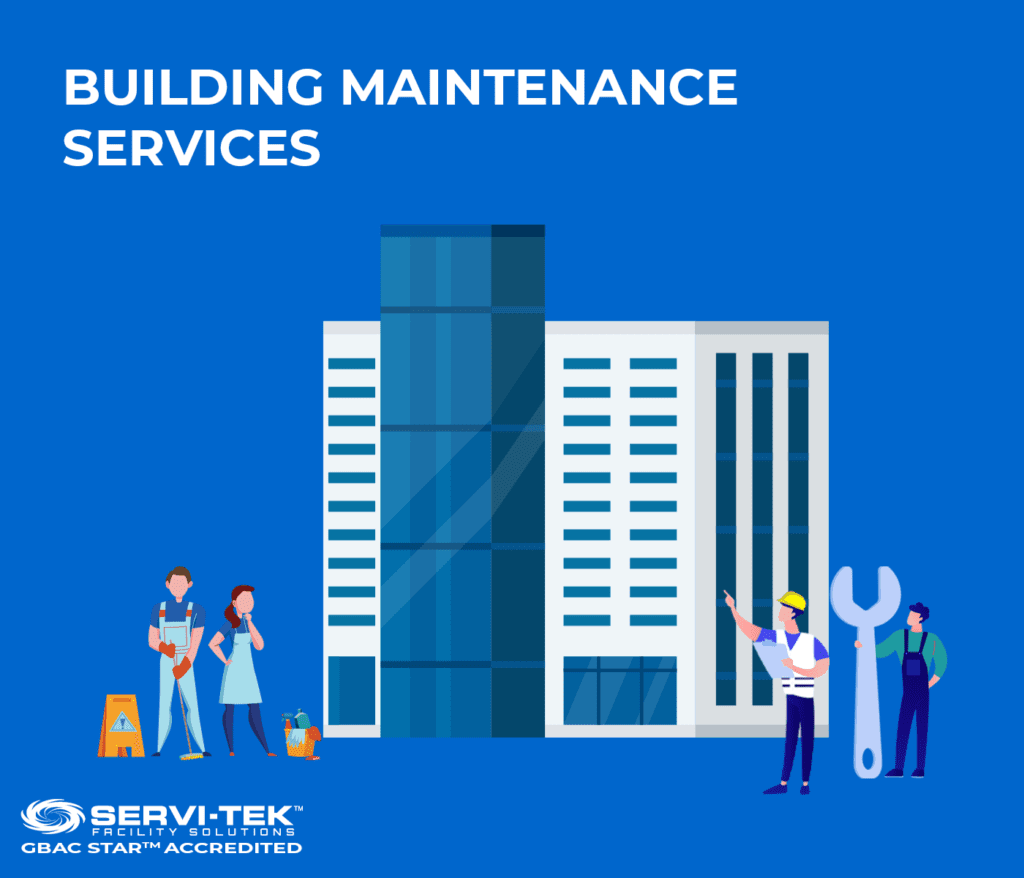
Let’s first start by properly defining building maintenance services.
In this context, maintenance – sometimes also referred to as engineering services – involves the act of maintaining types of property and equipment by delivering the highest level of service and professionalism.
The United States Bureau of Labor estimates that more than 1.4 million Americans are employed as workers in the realm of building repair and maintenance services.
Regular maintenance workers may include maintenance technicians, maintenance supervisors, chief engineers, and other facility management professionals that perform a variety of services for business operations.
What are Building Maintenance Services?

The variety of tasks involved in building maintenance include conducting inspections, undertaking urgent repairs, responding to staff or tenant requests, and performing general building maintenance functions.
Facilities maintenance services are performed by an in-house maintenance team, or by an outsourced commercial maintenance company.
The goals typically include cost-effective service excellence and consistency in preventative maintenance to achieve comfort and safety for employees, tenants, and visitors.
Building maintenance and engineering services often involve heating ventilation and air conditioning (HVAC) systems, plumbing, electrical, and general repairs.
Maintenance techs are trained and may have system maintenance certifications and operator certifications.
Many begin by working apprenticeships and look for growth opportunities for a smooth transition to becoming maintenance industry leaders.
Maintenance technicians operate in potentially hazardous conditions requiring adherence to industry best practices and Occupational Safety and Health Administration (OSHA) guidelines.
This industry work requires attention to detail, adopting innovations, maintaining excellent documentation, and following manufacturer specifications.
Seasoned facility managers and maintenance professionals know the importance of customizing their plans according to their own goals and property needs.
Commercial environments have vastly different purposes, are subject to various conditions, and contain a host of various equipment and systems.
What Are Some of the Services Provided by Building Maintenance Companies?
Many different areas require engineering or maintenance functions in commercial buildings.
Air-Conditioning Maintenance
The building’s heating, ventilation, and air conditioning (HVAC) system require maintenance to keep the equipment operating efficiently and reliably.
Employees, tenants, visitors, and other building occupants also depend on the HVAC system for comfort and indoor air quality.
Potential signs of problems include insufficient heating or cooling levels, and unplanned breakdowns requiring extended repairs.
HVAC units typically having filters that must be inspected and/or replaced at some regular intervals.
Complex central-plant equipment includes chillers, cooling towers, and associated systems that require as-needed repairs and ongoing preventive maintenance performed.
Electrical Maintenance
Electrical maintenance tasks may vary from relatively minor repairs to those that can be more involved and require an electrician.
Burned-out lightbulbs and ballasts are among the most basic service calls.
Another common problem is when the circuit breakers are tripping, which suggests excessive energy draw is causing an overload.
A new circuit might be necessary based on research.
Major components of the facility or property’s electrical distribution system also warrant attention and, where necessary, repair.
Examples include transformers, main switchgear, and emergency generator backup.
Life Safety
Most commercial buildings today have multi-faceted fire prevention and suppression systems.
Sensors are often tied into a central annunciator or alarm panel.
The building engineering or maintenance department is often responsible for coordinating timely testing, inspection, and possible maintenance or replacement of components, such as smoke detectors.
The fire alarm system will generally have audible alerts, such as horns, and visible emergency strobe lighting.
The fire suppression system typically involves a system of sprinklers that work with a water supply and pumps for high-rise properties.
Other components needing routine inspection include fire extinguishers.
The maintenance staff is also typically responsible for inspecting and testing all exterior and interior emergency lights and exit sign lights.
Plumbing
Plumbing services high-usage areas such as kitchens or break rooms, as well as restroom facilities.
Engineering is often called up to clear blockages in drain lines and replace hardware components such as faucets and even inoperable toilets.
In vertical commercial facilities or properties, maintenance is also required on domestic water pumps.
Why is Building Maintenance Important?

Building maintenance or engineering professionals strive to maintain overall facility safety.
The condition of buildings and the equipment within tends to decline over the years and overall efficiency can erode.
If building and equipment maintenance is deferred, the systems and equipment can be more prone to failure, raise potential liability, require additional manpower to maintain, reduce efficiency and increase utility consumption.
These factors could increase operating expenses and reduce staff and tenant satisfaction.
This is important for reducing the likelihood that small problems develop into much more significant and costly ones.
Building maintenance is a critical aspect of facility management and commercial operations regardless of the industry.
While all commercial facilities and properties have building maintenance requirements, the nature of the work varies considerably.
Effective building maintenance is based on creating a plan, initial and ongoing training, and leveraging new technologies.
These three keys are all dependent on one another, such as how incorporating new technology requires retraining and acquiring knowledge.
When these shifts occur, it could change the overall plans or processes within your larger facility maintenance program.
Regardless of whether the maintenance services are performed by in-house staff or a third-party provider, they are critical.
The leading reasons include the health and safety of occupants, preventing major costly repairs, and maintaining a good appearance.
In a large commercial environment, the nature of the repair and maintenance functions can require extensive training and certification.
Minimizing potential liability, for example, can also be crucial to utilize a specialized contractor to perform testing, repairs, and upgrades.
For example, those who perform service and repair work on electrical, plumbing, or HVAC systems must have proper training and experience.
Usage of proper personal protective equipment (PPE) is also a must.
Building Maintenance Services: Types of Properties

The overall maintenance plan, as discussed, is partly developed based on the type of physical plant.
We will look at several commercial asset types, which have unique systems and requirements.
Public Buildings
Properties deemed as public facilities are typically funded in some part by the local, state, or federal government.
Examples may include public libraries, medical clinics, educational institutions, and transportation projects.
Schools are among the most populated public settings that have often very extensive maintenance requirements due to the nature of occupancy and standard of care guidelines.
Industrial Facilities
Buildings categorized as being industrial are often very expansive and have exterior points of entry for shipping and receiving.
They commonly have elaborate HVAC systems, and systems of electrical distribution, and may have a refrigerated area.
Manufacturing activity is commonly performed or various types of light industrial work.
Industrial venues often have large warehouse areas where goods are stored and prepared for distribution.
These buildings may be multi-purpose or flexible, such as with an attached office space.
Commercial Office Buildings
These commercial assets typically are multi-tenant properties designed to provide the needs of business users during normal business hours.
Commercial office buildings range from high-rise structures in a central business district to low-density projects – often in a cluster or office park setting – in the suburbs.
This property segment generally includes elevators, parking structures, and a need for efficient climate control.
New construction build-outs to accommodate new tenancy is common.
Medical
Whether this type of commercial property is a clinic, medical office building, or hospital, the needs are similar.
Redundancy of critical systems is key.
Hospitals have maintenance staff on-site 24 hours a day.
Larger backup generators are required to support patient services, including surgical procedures.
Responding to emergencies, including natural disasters and fire alarms requires the full attention and ongoing training of maintenance departments.
Retail Projects
Retail properties can range from large regional-type malls, neighborhood centers, or smaller strip projects.
These properties are typically open longer hours than other commercial real estate assets.
Tenants are almost always responsible for maintenance repairs within their premises.
HVAC systems can range from large central-plant systems to individual package units servicing individual tenants.
Back-up or auxiliary lighting systems are important due to the nature of occupancy.
PREVENTIVE MAINTENANCE
Preventative building maintenance is a critical function that involves performing proactive service and repair tasks to components or equipment.
A facility or building should have a detailed preventative maintenance plan that outlines all tasks and actions needed for the upkeep of the facility’s equipment and systems.
The preventive maintenance schedule guides the facility maintenance team regarding the tasks to perform and the frequency of these actions, such as checking filters or fluid levels, and other activities involving inspection or testing.
For example, maintenance tasks might be organized according to frequency; such as those performed on a daily, weekly, or monthly basis.
Some of the goals associated with a professional preventative maintenance program include optimizing performance, maximizing energy efficiency, and extending the serviceable lifespan of costly equipment.
In the absence of a professional preventative maintenance program, problems that often arise include unexpected downtime, premature equipment failure, and a host of possible safety concerns.
OUTSOURCED BUILDING MAINTENANCE SERVICES
What do third-party companies that offer engineering and facility maintenance services do? A professional provider of building maintenance services should strive for the following:
- Gain an understanding of their client’s goals and objectives
- Create a customized maintenance plan for the client
- Identify opportunities that will improve efficiency
- Leverage economies of scale as a means of reducing costs i.e., purchasing supplies in bulk
- Meeting or exceeding deadlines when performing time-sensitive projects
- Explore and potentially adopt types of emerging technology and new products or equipment available in the industry
Choosing A Building Maintenance Company
Choosing an outsourced provider of engineering or building maintenance services requires diligence.
You should seek recommendations from colleagues or members of professional organizations or associations.
Meet with several companies to assess their experience and the extent of their capabilities.
Ask the providers for references consisting of organizations they have had a past working relationship with.
Confirm that the company is properly licensed and fully insured. If needed, inquire about their availability for responding to after-hours emergencies and large-scale ad-hoc projects.
Choosing the right maintenance provider for your building requires considering other factors such as:
- Staff Training: The engineering and technical personnel should have ongoing training on industry standards and the use of property-specific equipment.
- Safety: Ask if they have a formal safety training program, which is a critical component of all maintenance services activity.
- Preventive Maintenance Software: Having comprehensive software with a work order module is important for proper execution and adherence to a preventive maintenance plan.
- Pricing: A written proposal, in the form of a professional service agreement, must clearly include all related prices.
The Leading Building Maintenance Services Company
For many years now, the professional team at Servi-Tek Facility Solutions has created transparent partnership solutions with facility and property managers.
Our experienced staff of experts specializes in generating customized plans for building and equipment maintenance that create property value.
We closely assess the physical plant, understand your goals, and develop comprehensive maintenance, service, and preventive maintenance strategy to protect your commercial real estate asset.
Servi-Tek also embraces the use of the latest technology and equipment for efficient operations, reporting, and tracking of your goals.
We look forward to discussing how we can benefit your organization and encourage you to contact our office today.




